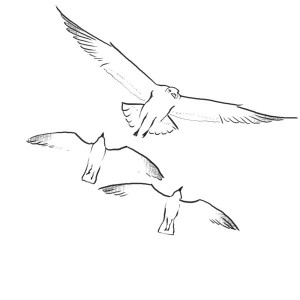
Continuing the series of pictures we couldn’t use in the book itself, here are some birdies.
Click on the images to see them larger and read more…


Continuing the series of pictures we couldn’t use in the book itself, here are some birdies.
Click on the images to see them larger and read more…
Rob and I both like to draw simply for our own enjoyment, and while we were writing and travelling for Skimming Stones and other ways of being in the wild, we did so pretty much continually.
Given the size and format of the final book, there was only space to include a select few of these drawings, but thankfully this blog gives us a chance to post some of the others and talk a little bit about them.
First, a few tales from the riverbank (click on the images to see them bigger and read more).
– Leo –
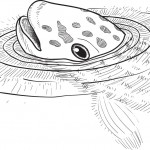
It’s been a remarkable week.
You can do a lot of preparatory work for something like a book launch – getting press lined up, going on the radio and so on – without having any clear idea if it’s working.
The proof is in the pudding, and I’m very pleased to say that Skimming Stones and other ways of being in the wild hit number 1 on Amazon under ‘Nature’ and ‘Outdoor pursuits’. This was, inevitably, short lived as the big name authors bounced back, but it’s still a lovely feeling to have seen our book above colossal powerhouses Richard Dawkins and Bear Grylls for a day!
The responses to our appearance on the Culture Show have been very gratifying, especially as it’s always difficult watching yourself or listening to your own voice on recordings. Andrew Graham Dixon was superb, and the camerawork, editing and overall structure really impressed me too – thanks to Jon Morrice, Neville Kidd and Douglas Kerr for doing such a good job, braving slippery seaweed, crumbling cliffs and sub-zero temperatures.
– Leo –

Christmas came early for me in 2010. I emerged from Kentish Town underground into falling snow and my leg buzzed into life with answer phone messages from a literary agent and a record label. I learnt in quick succession that in little over a year I would be having a book published and an album released. What’s more, they wouldn’t just be coming out in the same year and the same month, but in the same week.
I broke the news to Leo, as well as the rest of my band, before heading to the pub to celebrate. Looking back, I probably should have been more worried about the challenge that lay ahead. After all, although the book had been planned out and written up into a proposal, only the first chapter was actually finished. Although some songs were recorded, I wanted the album to be a coherent and progressive piece of work. An album of the old school vein, it had to span a whole raft of themes, not just be a collection of tunes.
 As you would imagine from its title, writing Skimming Stones and Other Ways of Being in the Wild required a lot of time spent outdoors. The book is about the simple things that we can all try that help us draw closer to, and reconnect with, nature; the importance of being, in every sense of that word, in the wild. It was going to be an amazing journey; a year of carving elder whistles in far-flung corners of woodland, building igloos on snow-topped mountains, sleeping in leaf shelters and cooking up on campfires under a clear canopy of stars. What it could not be was rushed.
As you would imagine from its title, writing Skimming Stones and Other Ways of Being in the Wild required a lot of time spent outdoors. The book is about the simple things that we can all try that help us draw closer to, and reconnect with, nature; the importance of being, in every sense of that word, in the wild. It was going to be an amazing journey; a year of carving elder whistles in far-flung corners of woodland, building igloos on snow-topped mountains, sleeping in leaf shelters and cooking up on campfires under a clear canopy of stars. What it could not be was rushed.
Leo and I circled the days we would be travelling and writing. The few windows left for creating and recording an album seemed too few; they would need to feature nose-to-the-grindstone songwriting and studio time. It was hardly the Rolling Stones-style ‘year-on-a-Caribbean-beach-polishing-off-chord-sequences-with-a-pina-colada’ I had imagined.
 So, how do you write a book and album in a year? Well they say if you want a job doing, give it to a busy man. In my favour, I have always written words and music simultaneously. I see no real difference in the creative process of either. Some ideas turn out to be a nice paragraph, others fit perfectly with a chord sequence. I am drawn to writers whose lines seem musical too; Roger Deakin’s nature writing, Dylan Thomas’ prose, Kerouac’s jazz-like rambles. Similarly, I have always been a lyrics man and it is the more narrative musicians that affect me most. I was also lucky that I was working with Leo and the boys in the band – all stagger me with their talent and ability to realise a vision.
So, how do you write a book and album in a year? Well they say if you want a job doing, give it to a busy man. In my favour, I have always written words and music simultaneously. I see no real difference in the creative process of either. Some ideas turn out to be a nice paragraph, others fit perfectly with a chord sequence. I am drawn to writers whose lines seem musical too; Roger Deakin’s nature writing, Dylan Thomas’ prose, Kerouac’s jazz-like rambles. Similarly, I have always been a lyrics man and it is the more narrative musicians that affect me most. I was also lucky that I was working with Leo and the boys in the band – all stagger me with their talent and ability to realise a vision.
It was last February, that Leo and I bundled out of London to track animals in through the snow and mud of wintry West Wales. We were soon following a fox’s prints into a dark wood. Holed up and waiting for its return as night fell seemed unnatural and unnerving. We talked in hushed whispers about things neither of us had discussed with each other before, our childhoods, growing up. Over those first few weeks writing we came back to the point time and again, that as we look more closely into the land we invariably look more closely into ourselves. It was something that would become a defining element to the book. It became more reflective, more philosophical. As well as imparting the techniques for the simple things that draw us closer to nature, we were writing about its impact on us too, the benefits of birdsong on the human brain or how finding a fossil can bring a unique and important perspective on our own life and death.
This changed my songwriting too. It became rawer, as honest as I could stand to make it, exploring something of what it is to be alive in Britain today. One night I watched a video of that punk pioneer Malcolm McLaren railing against what he saw as the burgeoning ‘karaoke culture’ and calling for people to be true to themselves, to create. This struck a chord with me. I started thinking of songwriting as a process indistinct from chopping wood; it has to have our sinews, sweat and tears.
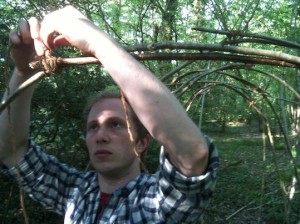 As I wrote, surprising crossovers between the book and album began emerging. Leo and I had found a unified voice easily and we were writing of the change that occurs when we take the time to leave the urban and walk out into the wild. These are experiences that can be heard on the album too; as we spent days doing things I had last done as a boy, I remembered things from my childhood I had thought forgotten. This gave rise to songs like ‘Sleeping in the Woods’ and ‘The Fire’: “Somehow I felt peaceful there, flames licking up the cool, night air. Wind whispering through the telegraph wire, singing to the fire.”
As I wrote, surprising crossovers between the book and album began emerging. Leo and I had found a unified voice easily and we were writing of the change that occurs when we take the time to leave the urban and walk out into the wild. These are experiences that can be heard on the album too; as we spent days doing things I had last done as a boy, I remembered things from my childhood I had thought forgotten. This gave rise to songs like ‘Sleeping in the Woods’ and ‘The Fire’: “Somehow I felt peaceful there, flames licking up the cool, night air. Wind whispering through the telegraph wire, singing to the fire.”
In finding the voice for the book, I had stumbled on my songwriting voice too, a voice I’d been chasing down and trying to perfect for nearly twenty years.
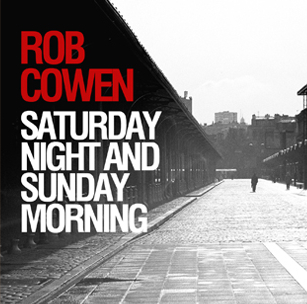 The rest of the band began to expect something new to learn every time we rehearsed. We had hit a rich seam and it soon became clear that we were really recording a double album: side one the full-band, epic-folk sound of a Saturday night, that feeling that no matter who you are, where you live or what job you do, the world is yours. Side two, the Sunday morning, was a dark dawn. The same things but viewed from the other side; faith, hope, love in the cold light of day. It was something we could all relate to. The characters were drawn from reality, people trying to make something for themselves, sometimes soaring, and sometimes falling.
The rest of the band began to expect something new to learn every time we rehearsed. We had hit a rich seam and it soon became clear that we were really recording a double album: side one the full-band, epic-folk sound of a Saturday night, that feeling that no matter who you are, where you live or what job you do, the world is yours. Side two, the Sunday morning, was a dark dawn. The same things but viewed from the other side; faith, hope, love in the cold light of day. It was something we could all relate to. The characters were drawn from reality, people trying to make something for themselves, sometimes soaring, and sometimes falling.
It strikes me now that the book and the album are about the same thing: learning to live in the place we find ourselves, both physically and mentally. Creating them at the same time meant each had a profound influence on the other; this gave me a new way of writing. Perhaps, ultimately, it was the making of both.
– Rob – 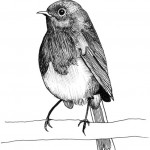
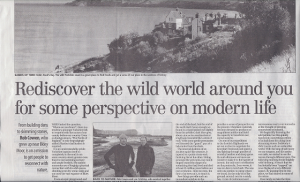 If you picked up yesterday’s Yorkshire Post, you may have noticed the lead feature was entitled ‘Rediscover the wild world around you for some perspective on modern life‘, an insightful and fascinating article that really tapped into the main arguments of our book. The author? One Rob Cowen. Guilty.
If you picked up yesterday’s Yorkshire Post, you may have noticed the lead feature was entitled ‘Rediscover the wild world around you for some perspective on modern life‘, an insightful and fascinating article that really tapped into the main arguments of our book. The author? One Rob Cowen. Guilty.
For those of you not in the know, the Yorkshire Post is rightly regarded as Yorkshire’s ‘national newspaper’ and the feature, and accompanying images of Leo and I looking fresh-faced and fancy free on the stretch of Jurassic coast running between Robin Hood’s Bay and Staithes, will hopefully help to highlight the importance of reconnecting with nature to the lucky residents of the UK’s largest county.
This heralds the start of a busy week ahead of us. Over the next few days we will be undertaking all manner of promotional and press work as the book finally hits the shelves (wooden, metal and virtual) on Thursday. On the same day, I will be taking to the stage to present to the Yorkshire Post Literary Luncheon; a fine tradition of speeches given by incredible authors such as Pam Ayers and Michael Dobbs, it is also a platform for terrified first-timers like myself.
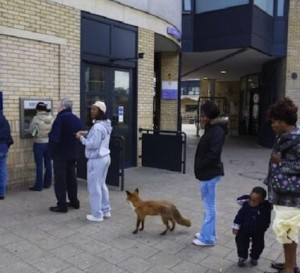 Then Saturday sees the rekindling of our monthly column in The Independent, starting with the ideal activity to help you slow down and reconnect with the fields and forests: animal tracking. We spent a fantastic day last February tracking a fox through a wood in Wales, waiting up as darkness fell to see his return. He was wolf-like in his wildness, a thick-maned manifestation of the dark wood itself; a very different experience to encountering the more urbanised Reynard, as this image of one queueing for a cash machine (courtesy of @Alsboy) shows!
Then Saturday sees the rekindling of our monthly column in The Independent, starting with the ideal activity to help you slow down and reconnect with the fields and forests: animal tracking. We spent a fantastic day last February tracking a fox through a wood in Wales, waiting up as darkness fell to see his return. He was wolf-like in his wildness, a thick-maned manifestation of the dark wood itself; a very different experience to encountering the more urbanised Reynard, as this image of one queueing for a cash machine (courtesy of @Alsboy) shows!
We are then appearing on BBC2’s The Culture Show, which airs on Saturday evening at 6pm. Viewers will get to see us skimming stones and building dens with presenter, Andrew Graham-Dixon as he attempts to get to the heart of the book and understand why slowing down and undertaking simple activities in nature is so beneficial to us.
Please watch/read/enjoy and let us know what you think!
– Rob – 
Yesterday, I had a very pleasant chat with Sean Moncrieff on NewsTalk Ireland.
We talked in particular about the transformative effect that spending quality time in nature can have.
As you become an adult, there’s a lot of other pressures, and these things fall by the wayside… there are parallels with meditation; little rituals that help you become mindful and bring yourself back into the moment…
There’s so much in favour of spending time reflecting on and experiencing nature. We all know this instinctively, we prefer a room with a view or a house with a garden, and yet many of us rarely take advantage of the abundant (and potentially free!) resources out there.
Listen to Leo on NewsTalk Ireland
– Leo –

Rob spoke to Hannah Murray at Talk Radio Europe: Spain a couple of days ago.
Nowadays, less than a quarter of children visit a local patch of green weekly. What sort of damage could this do in the long run?
The human animal evolved to live in nature, and it has a very powerful effect on us when we spend time in nature – when we slow down and spend time in it.
Are we so worried about the risks of letting children roam, that we are exposing them to the larger risks of becoming disconnected from the world around them, of becoming too used to fast-cut media and 2D screens?
Listen to Rob on Talk Radio Europe
– Leo –

We are now more than half way through writing our book, and I thought this might be a good time to reflect on the process and how it’s evolved as we’ve gone on.
Having already gone through several iterations of writing introductions and sample chapters while trying to get a publication deal, and put down tens of thousands of words that will never see the light of day, I don’t think either of us had any great sense of trepidation when time came to do things ‘for real’. We knew we could hit the word count, although a hard deadline would now dictate the pace rather than our ability to free up time.
What has been more surprising is the extent to which the writing has become quicker. Early chapters each felt like a new experience, breaking new ground and understanding better how the book would work. We advanced paragraph by paragraph, checking everything with one another and discussing extensively. Our overarching theme – that taking a turn through a natural setting is all very well, but slowing down to connect more deeply yields far greater rewards – is a powerful one I hope, but teasing out the different facets of it was a challenge.
It’s now a lot easier to see how each chapter fits into the whole, however. Along with the multitude of sketches we’ve both been doing, the sense of building a larger piece of work is invigorating. The book is like completing a puzzle, and it feels like we’ve got the edges in place now.
A lot of people ask how we can be joint authors, and whether we step on one another’s toes. We were conscious of this early on, but it never manifested itself as a problem. Now our style is established, and a good few chapters written, we are both writing sizeable passages before swapping over to add our own take to the other’s work. After a few iterations it’s often impossible to say who wrote a particular sentence. Being able to work in parallel in this way, I am sure we’re writing at least as quickly as a single author would do under the same circumstances, and it’s naturally a much more sociable task.
We’ve enjoyed it immensely so far, and are very much looking forward to getting the rest done and sharing it with the world.
– Leo
